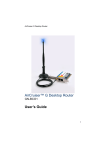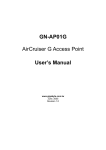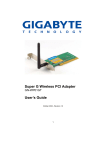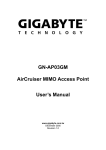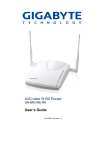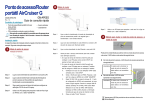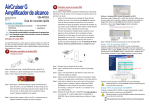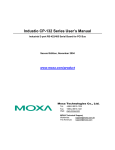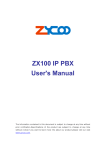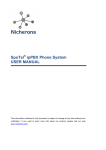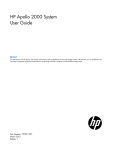Download GN-AP05G AirCruiser G Wireless Portable AP User`s Manual
Transcript
GN-AP05G AirCruiser G Wireless Portable AP User’s Manual www.gigabyte.com.tw Aug. 2005 Revision 1.05 GN-A11G Wireless LAN Access Point Federal Communication Commission Interference Statement This equipment has been tested and found to comply with the limits for a Class B digital device, pursuant to Part 15 of the FCC Rules. These limits are designed to provide reasonable protection against harmful interference in a residential installation. This equipment generates, uses and can radiate radio frequency energy and, if not installed and used in accordance with the instructions, may cause harmful interference to radio communications. However, there is no guarantee that interference will not occur in a particular installation. If this equipment does cause harmful interference to radio or television reception, which can be determined by turning the equipment off and on, the user is encouraged to try to correct the interference by one of the following measures: - Change direction or location of antenna. Increase the distance between the equipment and the antenna. Connect this equipment with a socket different from the one connected with antenna Ask help from experienced audio/video technicians. FCC Caution: To assure continued compliance, any changes or modifications not expressly approved by the party responsible for compliance could void the user’s authority to operate this equipment. This device complies with Part 15 of the FCC Rules. Operation is subject to the following two conditions: (1) This device may not cause harmful interference, and (2) this device must accept any interference received, including interference that may cause undesired operation. IMPORTANT NOTE: FCC Radiation Exposure Statement: This equipment complies with FCC radiation exposure limits set forth for an uncontrolled environment. This equipment should be install and operated with minimum distance 20cm between the radiator & your body. This transmitter must not be co-located or operating in conjunction with any other antenna or transmitter. The antenna(s) used for this transmitter must not be co-located or operating in conjunction with any other antenna or transmitter. FCC Caution: 1. The device complies with Part 15 of the FCC rules. Operation is subject to the following two conditions: (1) This device may not cause harmful interference, and (2) this device must accept any interference received, including interference that may cause undesired operation. 2. FCC RF Radiation Exposure Statement: The equipment complies with FCC RF radiation exposure limits set forth for an uncontrolled environment. This equipment should be installed and operated with a minimum distance of 20 centimeters between the radiator and your body. 3. This Transmitter must not be co-located or operating in conjunction with any other antenna or transmitter. 4. Changes or modifications to this unit not expressly approved by the party responsible for compliance could void the user authority to operate the equipment. 3 Contents Chapter 1 Introduction............................................................................................ 7 Overview ............................................................................................................... 7 Features................................................................................................................ 7 Package Contents ................................................................................................... 7 GN-AP05G Rear Panel ............................................................................................. 8 Status LEDs ........................................................................................................... 9 Side View .............................................................................................................. 9 Chapter 2 QUICK INSTALLATION............................................................................ 11 System Requirements ............................................................. 錯誤! 尚未定義書籤。 Installation ............................................................................................................11 Chapter 3 Configuration - Using A Web-Browser....................................................... 14 Using Web-based Configuration................................................................................ 14 Configuring the device for Access Point Mode Access .................................................... 15 Configuring the device for Router Mode Access ............................................................ 26 Chapter 4 Troubleshooting .................................................................................... 53 Appendix A: Glossary........................................................................................... 55 Appendix B: Specifications ................................................................................... 59 Physical Interface .................................................................................................. 59 Specifications ....................................................................................................... 59 Appendix C: PC Configuration ............................................................................... 60 TCP/IP Settings Under Windows 2000........................................................................ 60 TCP/IP Settings under Windows XP........................................................................... 63 v Chapter 1 Introduction Overview Thank you for purchasing GIGABYTE’s GN-AP05G AirCruiser G Wireless Portable AP. Carrying around an Access Point and Router has never been easier with the GN-AP05G AirCruiser G Portable Router. The sleek and compact design includes both Router and AP functionalities without affecting performance. With the added feature, switching between Router and AP modes can be done with a push-button. The GN-AP05G will deliver all your daily wired and wireless needs with its AP and Router functions (WDS, Dynamic & Static Routing and DHCP) and securities (WEP and Firewall). Configure your secured wireless network within minutes with GIGABYTE’s SmartSetup3. Features ¾ ¾ ¾ Wireless broadband gateway with full Router and AP functions Portable and compact design with built-in dual antennas Push button to switch between AP Mode and Router Mode Package Contents Before installing, please examine the components to ensure that none were damaged during shipping. The package contents of the GN-AP05G shall include: ; ; ; ; ; GN-AP05G AirCruiser G Wireless Portable AP Power Adapter Installation CD containing User’s Guide User’s Guide Ethernet Cable If there are any missing or damaged parts, please contact your local distributor or dealer immediately. If a replacement unit is needed, return the device with the original packing material, otherwise the warranty will be void. 7 AirCruiser G Wireless Portable AP GN-AP05G Rear Panel Z Y X The AirCruiser G Wireless Portable AP’s port is located on the rear panel and the antenna is located on the left side as shown from above. X Power Socket Connect the power adapter to the power socket and power outlet Y Ethernet LAN Port 10/100Mbps LAN connection with auto-sensing and MDI/MDIX Note: Z When AP05G is in AP mode, it will be LAN port. When AP05G is in Router mode, it will be WAN port. Initialize Button With a pin or paperclip depress for 5 seconds to reset the unit to factory settings 8 Status LEDs LED’s Please see the table below for a description of the LEDs: Label Power AP Router Ethernet Activity On (Green) Off On (Red) Blink (Green) Description Unit is receiving power and functioning Unit is not receiving power Unit is receiving power but not functioning System working as AP mode. Data is being transmitted wirelessly Blink (Green) System working as AP mode. Data is being transmitted wirelessly On (Green) LAN port has detected a link with a 10/100 Mbps device Blink Data is being transmitted Side View X X Mode Button You can press the Mode button to set the device in either Access Point mode or Router mode. 9 Chapter 2 QUICK INSTALLATION Installation Follow the steps below when installing your Wireless Portable AP(s). Before you begin, please keep the following in mind when placing your Wireless Portable AP(s). 9 Select a suitable location to install the Wireless Portable AP. Assure that the location is away from any interfering radio signals from devices such as microwave ovens, garage door openers, vacuum cleaning devices, etc. Please also operate the Wireless Portable AP in a cool dry place, away from direct sunlight. 9 Position the Wireless Portable AP appropriately. Signal strength is greatly dependent on your well placed Wireless Portable AP. Generally, a centralized area with 360° clear line of sight is the best location with the antenna in a high position to allow optimal propagation of the signal. The location of the Wireless Portable AP greatly influences the signal reception. The following installation steps are using the hotel Internet connection as example. Pease follow the instructions step by step. Access Point Mode Step 1 Plug the power adapter cord into the Portable AP/Router’s power jack and then plug the power adapter into a power outlet. Step 2 Connect the other end of the Ethernet cable to an applicable LAN port. Step 3 Please follow the hotel Internet service guide to configure the TCP/IP settings of your PC/Laptop. Step 4 Please use your PC/Laptop to scan the wireless network and connect to the AP05G with SSID “GIGABYTE”. 11 AirCruiser G Wireless Portable AP Router Mode Step 1 Plug the power adapter cord into the Portable AP/Router’s power jack and then plug the power adapter into a power outlet. Step 2 Connect one end of the Ethernet cable to the LAN connector of the Wireless Portable AP/Router. Step 3 Connect the other end of the Ethernet cable to an applicable LAN port. Step 4 Based on the LAN service of the hotel room, there are two possible setting as following. 1. If the hotel Internet service guide asks you to setup your PC/Laptop as DHCP enable, you don’t need to anything at setp4. 2. If the hotel Internet service guide asks you to setup your PC/Laptop as static IP address, you need to configure the AP05G with the static IP address. A. Make sure your TCP/IP setting is DHCP enable B. Use WLAN connect to AP05G: Scan the wireless network and connect to the AP05G with SSID “GIGABYTE”. C. Type 192.168.1.254 at the IE browser. Now the configuration screen of AP05G will appear as following figure. Please fill in the WAN IP address, WAN subnet Mask, WAN Gateway, and DNS by using the information provided by the hotel Internet service guide. D. Click the “finish” button. 12 Step 5 Please use your PC/Laptop to scan the wireless network and connect to the AP05G with SSID “GIGABYTE”. AP Mode and Router Mode Change Method You can press the Mode button to toggle the mode between Access Point mode and Router mode. The LED will indicate the current mode as following. ♦ In AP mode, the AP LED status: Blink ♦ System working as AP mode. Data is being transmitted wirelessly In Router mode, the Router LED status: Blink System working as AP mode. Data is being transmitted wirelessly 13 AirCruiser G Wireless Portable AP Chapter 3 Configuration - Using A Web-Browser This section explains the web-based configuration method of setting up the Wireless Portable AP. Any Internet Explorer 5.0 or above or Netscape Communicator 6.0 or above may be used to administer the GN-AP05G AirCruiser G Wireless Portable AP. Using Web-based Configuration Open the web-browser of your choice, and enter the local IP address of the GN-AP05G AirCruiser G Wireless Portable AP into the address line of browser. (The factory default local IP is 192.168.1.254) and press Enter. The screen shown as below will appear. In lowercase letters, enter the default user name and password, admin, in the User Name and Password fields. Click the OK button. 14 Configuring the device for Access Point Mode Access The LAN Configuration Screen LAN Configuration Allows you to modify the LAN parameters, and if you want to enable DHCP automatic IP address assignments, you can enable it here, and specify a Start and End address for the IP range. DHCP Option The DHCP server "leases" out address for specific times (Time To Live) to the various hosts. If a host does not use a given address for some period of time, that IP address can then be assigned to another machine. When assignments are made or changed, the DHCP server must update the information in the DNS server. The AirCruiser G DHCP Lease Table displays the associated IP/MAC assignment and Time To Lease. Force IP-MAC Mapping Allows you to manually assign a specific IP address to a specific network device (MAC address) on the network. This will be updated in the ARP table automatically. Verify the settings, and then apply these to your AP, click the Submit button. 15 AirCruiser G Wireless Portable AP The Wireless Configuration Screen The Wireless Configuration screen allows you to configure the AP’s WLAN function. The 802.11g Tab Region Indicates the geographical region you are in. Verify that the region indicated is correct. If not, please contact your local distributor or dealer immediately. 802.11g Only Mode The mixture of both 11b and 11g traffic on your wireless network results in the reduction of the network performance. For this reason, the 802.11g Only Mode allows you to restrict all traffic to 11g (54Mbps) traffic only. Keep in mind, however that enabling this feature comes at the expense of eliminating all 11b based traffic by the AirCruiser G. Enable will restrict all traffic to 802.11g traffic, while disable will allow a mixture of both 11b and 11g. The default setting is Disable. Channel The channel may be manually changed (if there are other wireless networks operating in your area) by selecting a channel from the drop-down list. SSID The SSID (Service Set Identifier) is the name of your wireless network. The SSID is up to 32 ASCII characters in length and case sensitive (i.e. Letters in upper case “A~Z” and lower case “a~z” are unique). The default SSID is “GIGABYTE”. To change the SSID, type in the SSID you want to use in the SSID field and click Submit. If you make a change to the SSID, any wireless devices on your network must also be reconfigured to connect to the new network name. Rate Select a wireless data transmission rate from the drop- down list. The default setting auto/best automatically detects and sets the optimum transmission rate. Hidden SSID For security purposes, you may choose to hide your network’s SSID by selecting enable from the drop-down list. This will prevent computers scanning for the presence of wireless networks to detect your network name. The default setting is disable. Authentication Type Select an authentication type from the drop-down list. The default setting is Open System. Open System: The sender and the receiver do NOT share a secret key. Each party generates its own key-pair and asks the receiver to accept a randomly generated key. Once accepted, this key will only be 16 used for a short period of time. Afterwards, a new key will be generated and agreed upon. Shared Key: Authentication is based upon a secret key shared by both the sender and the receiver. If Shared Key is selected, you cannot choose the WEP disable option. WEP Key The AirCruiser G supports two WEP standards: 64-bit,152-bit. Select either 64-bits or 152-bits from the drop-down list activate WEP encryption. The 64-bits encryption uses 40 bits as a secret key, (user-defined) and the remaining 24 bits are reserved. The 128-bits encryption uses 104 bits as a secret key, (user-defined) and the remaining 24 bits are reserved. WPA Re-key Enabling the requirement for WPA rekeying of a Passphrase for increased security. Default is disable. WEP Re-key Timer Specify time (in minutes) for expiration of the current WPA Key. WPA PSK Passphrase The Passphrase must be between 8 and 64 characters. WPA PSK Re-key A user without a RADIUS server, may specify generating a new WPA PSK key more frequently than each time he connects to the network. WPA PSK Re-key Timer Specify time (in minutes) for expiration of the current WPA PSK key 17 AirCruiser G Wireless Portable AP The MAC Access Control Tab The MAC Access Control screen allows you to specify the Media Access Controller (MAC) address of up to 32 devices on your network. Only those devices listed in the table will have access to transmit data through the AirCruiser G. In this way, even if someone manages to obtain all the information necessary to connect to your network, if their MAC address is not permitted, they still cannot connect. Keep in mind, however that MAC addresses can be spoofed, so it is not a panacea but rather another component of your existing security process. Enable the feature, then key in the MAC addresses to be allowed. Enter the MAC in the form separated by colon. The default setting is Disable. 18 The WDS Tab The WDS function allows several of the access points to compose a wide Wireless LAN network. Please note all APs must be set to use the same channel and the SSID of all participating APs must also be the same. WDS technologies between AP manufactures vary, so you may not be able to establish WDS if you use APs of different brand names. 19 AirCruiser G Wireless Portable AP The Change Password Screen The Change Password screen allows the administrator to create a new password for the AirCruiser G portable AP. To change an existing password, enter your account and new password and after re-typing the password to confirm, click the Submit button. Note: Remember to enter this new password when logging into the AirCruiser G Portable AP. The Upgrade Firmware Screen The Upgrade Firmware screen allows you to update the current AirCruiser G Portable AP firmware to the latest version directly from the GIGABYTE website. Click the Browse button to locate the firmware file which you just downloaded from the GIGABYTE website, and then click Upgrade. 20 The BackUp/Restore Screen The Backup / Restore screen allows you to save the current configuration settings of the AirCruiser G Portable AP as a temp file onto your computer. To revert the AP back to a previously saved configuration settings, click the Browse to locate the saved configuration file. Then, click the Restore button. The Ping Screen ‘Pinging' involves sending a packet of data to a site and recording how long it takes for the site to acknowledge receipt. This is useful if you think that a web site might be slow or unavailable. Type the IP Address and click the Ping button to start. 21 AirCruiser G Wireless Portable AP The Reboot Screen The Reboot screen allows you to reboot the AirCruiser G Portable AP. You are also automatically brought to this screen after you confirm OK to any change of AP settings. The Log Information Screen The AirCruiser G Portable AP keeps logs of all port activity and events which cause a state change. 22 The Status Information Screen On the Status page the portable AP’s current connection and configuration information is displayed for the following; LAN Ethernet, WAN Ethernet, Wireless Status, ARP Table, DHCP Lease Table, Routing Table. LAN IP Address Displays the primary IP address being used by the Local (LAN) port of the AP. The default is 192.168.1.254 LAN Netmask Displays the IP Subnet Mask being used by the Local (LAN) port of the AP. Default is 255.255.255.0 LAN DHCP Status Identifies if the AP’s built-in DHCP server is active for the attached devices on the LAN. LAN DHCP Start IP The starting IP number in the range possible IP addresses issued by the DHCP server. LAN DHCP End IP The last IP number in the range possible IP addresses issued by the DHCP server. 23 AirCruiser G Wireless Portable AP The LAN Ethernet Status button MAC This field displays the MAC address of the portable AP as seen on your wireless network. MTU This specifies the maximum size of the packet permitted for Internet transmission. Rx packets The number of data packets received by the AP. Tx packets The number of data packets transmitted by the AP. Rx bytes The current bandwidth (receive) on the LAN port. Rx bytes The current bandwidth (transmit on the LAN port. The WAN Ethernet Status button MAC The field displays the MAC address used by the WAN port of the AP. MTU The maximum size of the packet sent from your computer to the Internet. Rx packets The number of received packets of this port after resetting or manually initial. Tx packets The number of transmitted packets of this port after resetting or manually initial. Rx bytes The current bandwidth (receive) on the WAN port. Rx bytes The current bandwidth (transmit) on the WAN port. The Wireless Status MAC The field displays the MAC address used by the AP when wireless. Rx packets The number of received packets of this wireless port after resetting or manually initial. Tx packets The number of transmitted packets of this wireless port after resetting or manually initial. Rx bytes The current reception bandwidth on the Wireless LAN. Rx bytes The current transmission bandwidth on the Wireless LAN. ARP Table The ARP Table displays the associated MAC address and IP address pairs of your LAN devices. In the example below, only the AirCruiser G Portable AP is in the ARP Table. DHCP Lease Table The DHCP Lease Table displays the associated IP assignment. Routing Table The Routing Table displays the AirCruiser G RIP routing details. 24 The About Screen The About screen displays the device name as well as the firmware version. 25 AirCruiser G Wireless Portable AP Configuring the device for Router Mode Access SmartSetup 3 should open the web-based configuration screen, and auto detect your type of Internet Connection (PPPoE, Static, Dynamic, etc.) if it does not, simply type 192.168.1.254 into the address bar of your web browser. When prompted for username/password type: admin for both. Types of Broadband Internet connections automatically detected by SmartSetup 3: Dynamic IP Address If you use a dynamic IP address, you can directly connect to Internet without having to login. The Portable AP will then automatically restart. PPPoE Most common type of ISP Connection. If you use a PPPoE connection, please enter your ISP user ID and password. Static IP address If you use a static IP address, please enter your WAN IP address, WAN subnet Mask, WAN Gateway, and DNS information provided by your ISP. The AirCruiser G Portable AP’s web browser based configuration screen will prompt you for certain ISP related information. You can contact your ISP service provider for this information at any time. After entering the ISP information, click the Finish button. The Router will save and restart automatically. The AirCruiser G Portable AP is now active! The SSID (Network Name) is GIGABYTE, and should now be visible from any wireless 11b or 11g adapter. 26 Configuration Utility – Advanced Setup Network Configuration Screen The Network Configuration screen consists of two sub-areas: LAN Configuration (which also includes DHCP Options, and Forced IP-MAC Mapping), and WAN Configuration in which you can configure up to 4 backup WAN connections (other internet service providers accounts) in the event your primary WAN connection fails. The LAN Configuration Tab LAN Configuration Allows you to modify the LAN parameters, and if you want to enable DHCP automatic IP address assignments, you can enable it here, and specify a Start and End address for the IP range. DHCP Option The DHCP server "leases" out address for specific times (Time To Live) to the various hosts. If a host does not use a given address for some period of time, that IP address can then be assigned to another machine. When assignments are made or changed, the DHCP server must update the information in the DNS server. The AirCruiser G DHCP Lease Table displays the associated IP/MAC assignment and Time To Lease. Force IP-MAC Mapping Allows you to manually assign a specific IP address to a specific network device (MAC address) on the network. This will be updated in the ARP table automatically. Verify the settings, and then apply these to your AP, click the Submit button. 27 AirCruiser G Wireless Portable AP WAN Configuration Tab Select the type of Internet Service you are using, and press the NEXT>> button to continue with modifications. Note: If you don’t know which type of Internet connection you have, click SmartSetup button, and it will auto detect this for you. A screen based on the Internet (WAN) connection type you selected will appear and provide parameter fields. Dynamic IP Address Host Name This is a free form field (Default GN-AP05G) which assigns a host name to your IP connection. You may choose a name of your preference, or leave the default. Press Finish. 28 PPPoE Your Internet Service Provider will supply you with the following account information you will need: • • • • • • ISP Name User ID/Password Service Name AC Name DNS1 and DNS2 Address DNS Domain Name Enter the information provided by your ISP in the fields provided. Static IP Address Your Internet Service Provider will supply you with the following account information you will need: • • • • • ISP Name WAN IP Address WAN Subnet Mask WAN Gateway DNS1 and DNS2 29 AirCruiser G Wireless Portable AP • DNS Domain Name This information is all provided by your ISP. IP addresses, you will only need to one. In the event that your ISP has assigned you several Static Wireless Configuration Screen The Wireless Configuration screen allows you to configure the Portable AP’s WLAN function. The 802.11g Tab Region Indicates the geographical region you are in. Verify that the region indicated is correct. If not, please contact your local distributor or dealer immediately. 802.11g Only Mode The mixture of both 11b and 11g traffic on your wireless network results in the reduction of the network performance. For this reason, the 802.11g Only Mode allows you to restrict all traffic to 11g (54Mbps) traffic only. Keep in mind, however that enabling this feature comes at the expense of eliminating all 11b based traffic by the AirCruiser G. Enable will restrict all traffic to 802.11g traffic, while disable will allow a mixture of both 11b and 11g. The default setting is Disable. Channel The channel may be manually changed (if there are other wireless networks operating in your area) by selecting a channel from the drop-down list. SSID The SSID (Service Set Identifier) is the name of your wireless network. The SSID is up to 32 ASCII characters in length and case sensitive (i.e. Letters in upper case “A~Z” and lower case “a~z” are unique). The default SSID is “GIGABYTE”. To change the SSID, type in the SSID you want to use in the SSID field and click Submit. If you make a change to the SSID, any wireless devices on your network must also be reconfigured to connect to the new network name. Rate Select a wireless data transmission rate from the drop- down list. The default setting auto/best automatically detects and sets the optimum transmission rate. Hidden SSID For security purposes, you may choose to hide your network’s SSID by selecting enable from the drop-down list. This will prevent computers scanning for the presence of wireless networks to detect your network name. The default setting is disable. 30 Authentication Type Select an authentication type from the drop-down list. The default setting is Open System. Open System: The sender and the receiver do NOT share a secret key. Each party generates its own key-pair and asks the receiver to accept a randomly generated key. Once accepted, this key will only be used for a short period of time. Afterwards, a new key will be generated and agreed upon. Shared Key: Authentication is based upon a secret key shared by both the sender and the receiver. If Shared Key is selected, you cannot choose the WEP disable option. WPA Pre-shared key:, The WPA Pre-shared Key authentication standard uses a password or “ key” between 8 and 32 characters. This encryption key is changed after every dialog box using the Temporary Key Integrity Protocol (TKIP), which allows users to change keys based on dialog box and automatically synchronize keys between devices on the network. The TKIP encryption algorithm is stricter than the one used by WEP but is based on the same standard. WEP Key The AirCruiser G supports two WEP standards: 64-bit,152-bit. Select either 64-bits or 152-bits from the drop-down list activate WEP encryption. The 64-bits encryption uses 40 bits as a secret key, (user-defined) and the remaining 24 bits are reserved. The 128-bits encryption uses 104 bits as a secret key, (user-defined) and the remaining 24 bits are reserved. WPA Re-key Enabling the requirement for WPA rekeying of a Passphrase for increased security. Default is disable. WEP Re-key Timer Specify time (in minutes) for expiration of the current WPA Key. WPA PSK Passphrase The Passphrase must be between 8 and 64 characters. WPA PSK Re-key A user without a RADIUS server, may specify generating a new WPA PSK key more frequently than each time he connects to the network. WPA PSK Re-key Timer Specify time (in minutes) for expiration of the current WPA PSK key. 31 AirCruiser G Wireless Portable AP The MAC Access Control Tab The MAC Access Control screen allows you to specify the Media Access Controller (MAC) address of up to 32 devices on your network. Only those devices listed in the table will have access to transmit data through the AirCruiser G. In this way, even if someone manages to obtain all the information necessary to connect to your network, if their MAC address is not permitted, they still cannot connect. Keep in mind, however that MAC addresses can be spoofed, so it is not a panacea but rather another component of your existing security process. Enable the feature, then key in the MAC addresses to be allowed. Enter the MAC in the form separated by colon. The default setting is Disable. 32 The WDS Tab The WDS function allows several of the access points to compose a wide Wireless LAN network. Please note all APs must be set to use the same channel and the SSID of all participating APs must also be the same. WDS technologies between AP manufactures vary, so you may not be able to establish WDS if you use APs of different brand names. 33 AirCruiser G Wireless Portable AP The Static Routing Table Screen The Static Routing Table displays the AirCruiser G Portable AP routing settings. To add or modify, enter a value into the field and click the Submit button. Destination IP Enter the Destination IP address that will be assigned to a specific network or host. Netmask Enter the netmask associated with the Destination IP. Gateway Enter an IP address that will be assigned to the interface connecting to subnets. Metric The “Metric” value is a number between 1 and 15 that represents the number of Routers between your network and the destination. Generally, setting the Metric value as either 2 or 3 is sufficient for most applications. If this is a direct connection, please set the value to 1. 34 The Virtual Server Screen The DMZ Tab The DMZ feature allows you to specify the IP address of the computer that will be placed outside the firewall of your network. With a firewall setup, it is often necessary to place some clients outside of the firewall while leaving the others protected. You can do this using a Demilitarized Zone (DMZ) to test or configure some applications (e.g. Internet games, video conferencing, or VPN connections) or create a server connecting to the Internet through the Intranet. Enter the IP Address of your computer (e.g. 192.168.1.2) into the LAN IP Address field and click the Submit button. Note: DMZ servers pose a security risk. A computer designated as the default DMZ server loses much of the protection of the firewall, and is exposed to exploits from the Internet. If compromised, the DMZ server can be used to attack your network. 35 AirCruiser G Wireless Portable AP The PPPoE/DHCP/Static Tab A Virtual Server allows computers on the WAN side of the network to connect with a PC server on the LAN side of the network. For example, a PC on the LAN side with an IP address of 192.168.1.1 would have the following virtual server settings: ¾ ¾ ¾ ¾ Protocol: TCP Port: 21 Virtual Server IP: 192.168.1.1 Enable: enable In this case, any PC on the WAN side of the network can connect to the internal FTP server (192.168.1.1) using the IP address on the WAN end of the AirCruiser G Portable AP. 36 The Firewall Rule Screen The Firewall Rule screen displays your network security settings. Use this screen to quickly create network security policies to prevent unauthorized access to your network. The VPN Pass Through Tab PPTP Pass Through setting Point-to-Point Tunneling Protocol (PPTP) allows you to establish a connection to an enterprise network. With PPTP, if your device is located within a local network, you can share files and other data. IPSec Pass Through setting IP Security (IPSec) provides authentication and encryption. Since it is mainly a Layer 3 technology, it can secure all data on the network. It has become a standard protocol used with Virtual Private Networks (VPNs). 37 The Static Rule Tab Response Ping From WAN When enabled, prevents this Router and its privately assigned IP addresses from being broadcasted to the Internet. Allow Remote Management When enabled, allows remote configuration access via the Internet (WAN), else only local (LAN) access is allowed. Allow Microsoft NetBIOS Pass-through A File and Printer sharing security, that when enabled, only allows NetBIOS. Enable DoS Protection When enabled, Denial of Service type attacks are prevented. 39 AirCruiser G Wireless Portable AP The DNS Configuration Screen DNS Relay DNS Relay will set your PC's DNS entries to point to the Portable AP’s Gateway address, which will then forward DNS queries to the DNS server used by the Portable AP. This is needed when using DHCP to assign IP address to the PC’s in you LAN. The default value of DNS relay is Enable. Dynamic DNS The AirCruiser G Portable AP offers a Dynamic Domain Name Server (DDNS) service that allows you to assign a fixed host and domain name to a dynamic Internet IP address. This gives Internet users the ability to connect with a virtual sever using a FQDN, rather than with an IP address. Before using this feature, you must first register an account with the dynamic DNS service. (http://www.dyndns.org) Service Provider From this pull down menu, enter the DDNS service with which you have membership. Domain Name This is the DDNS URL assigned by the DDNS service. Login Name Enter the User Name for your DDNS account. Password Enter the Password for your DDNS account. Wildcards If your dynamic DNS provider allows using wildcards in resolving your URL, you may select Enable to activate this function. 40 The URL Blocking Configuration Screen The URL Blocking Configuration screen allows you to restrict access based upon specific web addresses and/or keywords. To activate the URL Blocking feature: 1. Select the Enable option. 2. Enter the keyword or domain in the Keyword field that you wish to block. 3. All URL’s with those keywords in the DOMAIN name will be blocked. Verify the settings and click the Submit button to accept these settings. To apply these settings, it is necessary to reboot the GN-AP05G. 41 Configuration Utility – Management Tool The instructions in this section will help you how to use the management tools of the web-based utility to effectively manage your AirCruiser G Portable AP. The PPP Monitor Screen The PPP Monitor screen displays the WAN (Internet) connection status. Click the Disconnect button to end your current session. Click the Connect button to re-connect to the ISP. 43 AirCruiser G Wireless Portable AP Manage Port Configuration Screen The Manage Port Configuration screen allows you to change the port on which the AirCruiser’s configuration utility runs. The default is Port 80 but users can change this to any port they wish (like 8080, 8000 or else port). In this case, to access the AirCruiser G configuration utility, you would type http://192.168.1.254:8080 The Reboot Screen The Reboot screen allows you to reboot the AirCruiser G Portable AP. You are also automatically brought to this screen after you confirm OK to any change of AP settings. 44 The Initialization Screen The Initialization screen allows you to reset the AirCruiser G back to its original factory settings. To initialize the AirCruiser G, use the tip of a pencil or a paperclip to press and hold the init button for 5 seconds and release. The Change Password Screen The Change Password screen allows the administrator to create a new password for the AirCruiser G. To change an existing password, enter your account and new password and after re-typing the password to confirm, click the Submit button. Note: Remember to enter this new password when logging into the AirCruiser G Portable AP. 45 AirCruiser G Wireless Portable AP The Change WAN MAC Screen The Change WAN MAC screen allows you to assign a new MAC address. If your ISP asks you to use the original MAC address, chose the Assign WAN MAC option and enter a new WAN MAC address in the New WAN MAC Address field and click the Submit button. If you want to restore the factory default MAC address, choose the Restore Default WAN MAC option and click the Submit button. Upgrade Firmware Screen The Upgrade Firmware screen allows you to update the current AirCruiser G Portable AP firmware to the latest version directly from the GIGABYTE website. Click the Browse button to locate the firmware file which you just downloaded from the GIGABYTE website, and then click Upgrade. 46 The Backup / Restore Screen The Backup / Restore screen allows you to save the current configuration settings of the AirCruiser G Portable AP as a temp file onto your computer. To revert the Portable AP back to a previously saved configuration settings, click the Browse to locate the saved configuration file. Then, click the Restore button. The Log Information Screen The AirCruiser G Portable AP keeps logs of all port activity and events which cause a state change. 47 AirCruiser G Wireless Portable AP The Ping Screen ‘Pinging' involves sending a packet of data to a site and recording how long it takes for the site to acknowledge receipt. This is useful if you think that a web site might be slow or unavailable. Type the IP Address and click the Ping button to start. The About Screen The About screen displays the AirCruiser G Portable AP name as well as the firmware version. 48 Configuration Buttons There are four buttons on the top left panel of the configuration menu; SmartSetup, Setup Wizard, Status, and Logout. These buttons are useful for accessing status information or setup wizard. Smart Setup Button SmartSetup automatically detects your ISP connection type, and opens the proper ISP login screen. Setup Wizard Button Setup Wizard is similar to Smart Setup, but also presents you with a LAN setup screen which allows you to set basic LAN configuration. 49 AirCruiser G Wireless Portable AP The Status Information Screen On the Status page the portable AP’s current connection and configuration information is displayed for the following; LAN Ethernet, WAN Ethernet, Wireless Status, ARP Table, DHCP Lease Table, Routing Table. LAN IP Address Displays the primary IP address being used by the Local (LAN) port of the AP. The default is 192.168.1.254 LAN Netmask Displays the IP Subnet Mask being used by the Local (LAN) port of the AP. Default is 255.255.255.0 LAN DHCP Status Identifies if the AP’s built-in DHCP server is active for the attached devices on the LAN. LAN DHCP Start IP The starting IP number in the range possible IP addresses issued by the DHCP server. LAN DHCP End IP The last IP number in the range possible IP addresses issued by the DHCP server. The LAN Ethernet Status button MAC This field displays the MAC address of the portable AP as seen on your wireless network. MTU This specifies the maximum size of the packet permitted for Internet transmission. Rx packets The number of data packets received by the AP. Tx packets The number of data packets transmitted by the AP. Rx bytes The current bandwidth (receive) on the LAN port. Rx bytes The current bandwidth (transmit on the LAN port. 50 The WAN Ethernet Status button MAC The field displays the MAC address used by the WAN port of the AP. MTU The maximum size of the packet sent from your computer to the Internet. Rx packets The number of received packets of this port after resetting or manually initial. Tx packets The number of transmitted packets of this port after resetting or manually initial. Rx bytes The current bandwidth (receive) on the WAN port. Rx bytes The current bandwidth (transmit) on the WAN port. The Wireless Status MAC The field displays the MAC address used by the AP when wireless. Rx packets The number of received packets of this wireless port after resetting or manually initial. Tx packets The number of transmitted packets of this wireless port after resetting or manually initial. Rx bytes The current reception bandwidth on the Wireless LAN. Rx bytes The current transmission bandwidth on the Wireless LAN. ARP Table The ARP Table displays the associated MAC address and IP address pairs of your LAN devices. In the example below, only the AirCruiser G Portable AP is in the ARP Table. DHCP Lease Table The DHCP Lease Table displays the associated IP assignment. Routing Table The Routing Table displays the AirCruiser G RIP routing details. 51 AirCruiser G Wireless Portable AP The Logout Button On the Logout page confirms that you have successfully logged out of the AirCruiser G Configuration. 52 Chapter 4 Troubleshooting This chapter gives information about troubleshooting your AirCruiser G Wireless Portable AP. Read the descriptions below for assistance is diagnosing and solving the problem. Q: A: What to do if you forget your password or forget the IP address of the Wireless Portable AP? Please press and hold for 5 seconds the “init” button at the bottom of the Wireless Portable AP. The Access Point will be reset to the factory default values, and the password will be restored to factory default. Q: A: I am unable to connect to the Internet. 1. Confirm that the power cord is connected properly and the Wireless Portable AP’s power LED is correctly lit. 2. Check whether all of the settings described in this manual are correctly set. 3. Verify that your ADSL/Cable Modem is operating normally, and/or you have ISP service available. 4. Check that your network cable is connected correctly, and the LED status is normal. Q: A: I am unable to access the Wireless Portable AP’s Web Configuration Interface. 1. Please check the Ethernet connection (RJ-45 LAN cable) between the PC and the Wireless Portable AP is properly connected. 2. Make sure your computer’s IP address is on the same subnet as the Wireless Portable AP. (Check this by typing ipconfig /all from a DOS command prompt) 3. Make sure you are carefully typing the correct IP address of the Wireless Portable AP in the address bar of your web browser. The IP address of your Wireless Portable AP is the “Gateway” address you see when you run the ipconfig /all command. 4. Try initializing your AP to factory settings. Q: A: What is the IEEE 802.11b standard? It is also referred to as 802.11 High Rate or Wi-Fi. It is an expansion to 802.11 that applies to wireless LAN and provides 11 Mbps transmission (with a fallback to 5.5, 2 and 1 Mbps) in the 2.4 GHz band. The 802.11b uses only Direct Sequence Spread Spectrum (DSSS). The 802.11b was a 1999 ratification to the origianl 802.11 standard, allowing wireless functionality comparable to Ethernet. Q: A: What is WEP? Wired Equivalent Privacy (WEP). A security mechanism defined within the 802.11 standard and designed to make the link integrity of the wireless medium equal to wired cable. Q: A: What is the IEEE 802.11g standard? IEEE 802.11g standard specifies data rates of up to 54 Mbps in the 2.45-GHz band. It uses Orthogonal Frequency Division Multiplexing (OFDM), which is the mandatory provisions have been made within the standard to make it inherently compatible with the well-established 802.11b standard at 11 Mbps, which uses Complementary Code Keying (CCK) modulation. Both .11g and .11b can operate at ranges of up to 300 feet. 53 Appendix A: Glossary 10BaseT The most common cabling method for Ethernet. 10BaseT conforms to IEEE standard 802.3. It was developed to enable data communications over unshielded twisted pair (telephone) wiring at speeds of up to 10 megabits per second up to distances of approximately 330 feet on a network segment. 802.11 A group of wireless networking standards, also known as Wi-Fi, set by the Institute of Electrical and Electronics Engineers (IEEE). 802.1X A standard for port-based authentication, first used in wired networks, that was adapted for use in enterprise WLANs to address security flaws in WEP, the original security specification for 802.11 networks. 802.1X provides a framework for authenticating users and controlling their access to a protected network and dynamic encryption keys to protect data privacy. Access Point An Access Point is a wired controller that sends data to the wireless NIC’s installed in your network computers, and received data back from them. An Access Point is often connected to the network computer that has Internet access, or is directly connected to an ADSL or cable modem. Ad-Hoc mode An old term used to describe a device-to-device network. (See device-to-device network, peer-to-peer network). ADSL Asymmetric digital subscriber line (ADSL) is a new modem technology that converts existing twisted-pair telephone lines into access paths for high-speed communication of various sorts. AES Advanced Encryption Standard. The preferred standard for the encryption of commercial and government data using a symmetric block data encryption technique. It is used in the implementation of WPA2. Auto-MDI/MDIX On a network hub or switch, an auto-MDI/MDIX port automatically senses if it needs to act as a MDI or MDIX port. The auto- MDI/MDIX capability eliminates the need for crossover cables. Auto-negotiate To automatically determine the correct setting. The term is often used with communications and networking. Bridge A wireless device that connects multiple networks together. BSSID Basic Service Set Identifier. A unique address that identifies the access point/router that creates the wireless network. Channel One portion of the available radio spectrum that all devices on a wireless network use to communicate. Changing the channel on the access point/router can help reduce interference. Client Any computer connected to a network that requests files and services (files, print capability) from the server or other devices on the network. The term also refers to end users. 55 AirCruiser G Wireless Portable AP Client devices Wi-Fi client devices include PC Cards that slide into laptop computers, mini-PCI modules embedded in laptop computers and mobile computing devices, as well as USB radios and PCI/ISA bus Wi-Fi radios. Client devices usually communicate with hub devices like access points and gateways. DHCP The Dynamic Host Configuration Protocol (DHCP) is an Internet protocol for automating the configuration of computers that use TCP/IP. DHCP can be used to automatically assign IP addresses, to deliver TCP/IP stack configuration parameters such as the subnet mask and default router, and to provide other configuration information such as the addresses for printer, time and news servers. DSSS Also known as “Direct Sequence Spread Spectrum,” this is a variety of radio transmission methods that continuously change frequencies or signal patterns. Direct Sequence Spread Spectrum (DSSS), which is used in CDMA technology,. multiplied the data bits by a very fast, pseudo-random bet pattern (PN sequence) that “spreads” the data into a large coded stream that takes the full bandwidth of the channel. DNS The Domain Name System (DNS) is a distributed Internet directory service.DNS is used mostly to translate between domain names and IP addresses, and to control Internet email delivery. Most Internet services rely on DNS to work, and if DNS fails, web sites cannot be located and email delivery stalls. Dynamic IP Address An IP address is automatically assigned to a user’s AP in a TCP/IP network typically by a DHCP server. EAP Extensible Authentication Protocol. A protocol that provides an authentication framework for both wireless and wired Ethernet enterprise networks. It is typically used with a RADIUS server to authenticate users on large networks. EAP protocol types are used in the 802.1X-based authentication in WPA-Enterprise and WPA2-Enterprise. Encryption A mechanism for providing data confidentiality. Ethernet The most popular international standard technology for wired Local Area Networks (LANs). It provides from 10 Mbps transmission speeds on basic 10BastT Ethernet networks to 100 Mbps transmission speeds on Fast Ethernet networks, 1000 Mbps on Gigabit Ethernet, and 10,000 Mbps on 10 Gigabit Ethernet. Firewall A system designed to prevent unauthorized access to or from a private network. Firewalls can be implemented in both hardware and software, or a combination of both.Firewalls are frequently used to prevent unauthorized Internet users from accessing private networks connected to the Internet, especially intranets.All messages entering or leaving the intranet pass through the firewall, which examines each message and blocks those that do not meet the specified security criteria. Firmware Software routines that are embedded as read-only memory (ROM) in a computer chip or hardware device to prevent modification of the routines. Unlike random access memory (RAM), read-only memory stays intact in the absence of electrical power. Startup routines and low-level input/output instructions are stored in firmware. Gateway A device, usually a Router, that connects hosts on a local network to other networks. 56 Infrastructure mode An old term used to describe a wireless network consisting of devices connected to a network using a centralized wireless access point. One of two types of wireless network modes; the other is a device-to-device network (also known as peer-to-peer or ad hoc mode). IP Address Every PC on the Internet has a fixed identifying number, called a IP Address. A typical IP address looks like this: 216.27.61.137 LAN A system of connecting PCs and other devices within the same physical proximity for sharing resources such as an Internet connections, printers, files and drives. When Wi-Fi is used to connect the devices, the system is known as a wireless LAN or WLAN. MAC Address On a local area network (LAN) or other network, the MAC (Media Access Control) address is your computer’s fixed hardware number.Usually written as: 01:23:45:67:89:ab Ping (Packet Internet Groper) A utility to determine whether a specific IP address is accessible. It works by sending a packet to the specified address and waiting for a reply. PING is used primarily to troubleshoot Internet connections. RADIUS Remote Access Dial-Up User Service. A standard technology used by many major corporations to protect access to wireless networks. RADIUS is a user name and password scheme that enables only approved users to access the network; it does not affect or encrypt data. The first time a user wants access to the network, secure files or net locations, he or she must input his or her name and password and submit it over the network to the RADIUS server. The server then verifies that the individual has an account and, if so, ensures that the person uses the correct password before she or he can get on the network. RADIUS can be set up to provide different access levels or classes of access. For example, one level can provide blanket access to the Internet; another can provide access to the Internet as well as to e-mail communications; yet another account class can provide access to the Net, email and the secure business file server. Like other sophisticated security technologies, RADIUS comes in a variety of types and levels. RJ-45 Standard connectors used in Ethernet networks. They appear similar to standard RJ-11 telephone connectors. However, RJ-45 connectors can have up to eight wires, whereas telephone connectors have only four. Roaming The ability to move seamlessly from one area of Wi-Fi or cellular phone coverage to another with no loss in connectivity. Roaming also refers to the ability of road warriors to wirelessly connect to the Internet from different hotspots without confronting the array of schemes used by different providers to authorize use and track billing. Roaming agreements among providers allow mobile professionals to a single authentication and authorization scheme to have all charges resolved to a single bill. Router A device that forwards data packets along networks. A router is connected to at least two networks, commonly two LANs or WANs or a LAN and its ISP network. Routers are located at gateways, the places where two or more networks connect. Server A computer that provides resources or services to other computers and devices on a network. Types of servers can include print servers, Internet servers, mail servers, and DHCP servers. A server can also be combined with a hub or router. 57 AirCruiser G Wireless Portable AP Site survey A comprehensive facility study performed by network managers to insure that planned service levels will be met when a new wireless LAN, or additional WLAN segments to an existing network, are deployed. Site survey’s are usually performed by a radio frequency engineer and used by systems integrators to identify the optimum placements of access points to insure that planned levels of service are met. Site surveys are sometimes conducted following the deployment to insure that the WLAN is achieving the necessary level of coverage. Site surveys can also be used to detect rogue access points. SSID The SSID is the name represents the routers and Access Point in wireless network. Subnet Mask A mask used to determine which subnet a IP address belongs to. An IP address has two components, the network address and the host address. Subnetting enables the network administrator to further divide the host part of the address into two or more subnets. Switch A type of hub that controls device usage to prevent data collisions and insures optimal network performance. A switch acts as a network traffic cop: Rather than transmitting all the packets it receives to all ports, as a hub does, a switch transmits packets to only the receiving port. TCP/IP TCP/IP (Transmission Control Protocol/Internet Protocol), the suite of communications protocols used to connect hosts on the Internet. TKIP Temporal Key Integrity Protocol. The wireless security encryption mechanism in Wi-Fi Protected Access. TKIP uses a key hierarchy and key management methodology that removes the predictability that intruders relied upon to exploit the WEP key. It increases the size of the key from 40 to 128 bits and replaces WEP’s single static key with keys that are dynamically generated and distributed by an authentication server, providing some 500 trillion possible keys that can be used on a given data packet. It also includes a Message Integrity Check (MIC), designed to prevent an attacker from capturing data packets, altering them and resending them. By greatly expanding the size of keys, the number of keys in use, and by creating an integrity checking mechanism, TKIP magnifies the complexity and difficulty involved in decoding data on a Wi-Fi network. TKIP greatly increases the strength and complexity of wireless encryption, making it far more difficult—if not impossible—for a would-be intruder to break into a Wi-Fi network. USB A high-speed bidirectional serial connection between a PC used to transfer data between the computer and peripherals such as digital cameras and memory cards. The USB 2.0 specification, announced in 2000, provides a data rate of up to 480 Mbps, 40 times faster than the original specification which provided only 12 Mbps. WAN Wide Area Network, a communication network that covers a relatively broad geographic area, consisting of two or more LANs. Broadband communication over the WAN is often through public networks such as the ADSL or Cable systems, or through leased lines or satellites. To simplify it, please image network as a WAN. WEP WEP (Wired Equivalent Privacy) is a data privacy mechanism based on a 64/128-bit shared key algorithm, as described in the IEEE 802.11 standard. 58 Appendix B: Specifications Physical Interface The Wireless Wireless Portable AP includes one Ethernet LAN port, one Initialize button and one antenna. Item Contents Description 1. Ethernet port 10/100Mbps Ethernet RJ-45 with auto-sensing and auto MDI/MDIX 2. 3. 4. 5. Switch button Init button Wireless antenna Power adaptor Switch between Router mode and AP mode Device reset (Init to factory default) Two internal antenna, 0dBi 5V, 1A Specifications System CPU, Flash and SDRAM Size RDC R2600, 1MB Flash, 8MB SDRAM Standards IEEE 802.3 (10BaseT), IEEE 802.3u (100BaseTX), IEEE 802.11b/g (Wireless) Operating Range Wireless - Open space: 100 – 300m; Indoor: 30 - 100m 5V, 710mA max. Power Consumption RF – 802.11g (backwards compatible to 802.11b) Frequency Band 2412 ~ 2484 MHz (subject to local regulation) Modulation Technology OFDM and DSSS Modulation Techniques 64QAM, 16QAM, QPSK, BPSK, DBPSK, DQPSK, CCK Data Rates 54, 48, 36, 24, 18, 12, 11, 9, 6, 5.5, 2, 1 Mbps, auto fallback Output power 20dBm Peak Power@ 54Mbps, Nominal Temp Range 20dBm Peak Power@ 11Mbps, Nominal Temp Range Receive Sensitivity Better than -68dBm; typical -71dBm @54Mbps, Nominal Temp Range Better than -83dBm; typical -85dBm @11Mbps, Nominal Temp Range Internal Antenna 0dBi x 2, supporting diversity Antenna Regulatory and Environmental Compliance EMC certification FCC part 15 (USA) CE (Europe) Temperature Range Operating: 0 ~ 40 degree C, Storage: -20 ~ 65 degree C Humidity 10% ~ 85% Non-condensing Mechanical Packaging Generic, GIGABYTE, private labeling optional LED indicator Power/Status LED (Dual Color, Green/Red) AP LED(Green) Router LED(Green) Ethernet Port LED (Dual Color, Green/Red) 80g (include Antenna) Weight 88.34mm x 63.46mm x 21mm Dimensions 59 AirCruiser G Wireless Portable AP Appendix C: PC Configuration To connect to the WIRELESS PORTABLE AP, your computer needs to be located in the same Subnet as the WIRELESS PORTABLE AP. Please follow the instructions given to setup in a TCP/IP network environment. By default, Windows 98, Me, 2000 and XP already have TCP/IP installed. If you have not installed the TCP/IP communication Protocol, please install it now, and then select your operating system for the setup. TCP/IP Settings Under Windows 2000 Step 1. Click the Start button, select Settings and then click the Control Panel icon. Step 2. Double-click the Network and Dial-up Connection icon. 60 Step 3. Double-click the “LAN CONNECTION” and click the “Properties” button. Step 4. The “Local Area Connection Properties” dialog box will appear. Verify that the Internet Protocol (TCP/IP) item is checked. Then double-click on Internet Protocol (TCP/IP). 61 AirCruiser G Wireless Portable AP Step 5. Assign the static IP address used by the WIRELESS PORTABLE AP and the same Subnet Mask to the computer (For example, IP address is 192.168.1.2 and Subnet Mask is 255.255.255.0), click the “OK” button to return to Local Area Connection Properties. Click the “OK” button again to complete the PC configuration. 62 TCP/IP Settings under Windows XP Step 1. Click the “Start” in the desktop of the Windows to select “Settings”, and then select the “Control Panel”. Step 2. Double-click the “Network Connections” icon. 63 Step 3. Double-click the “LAN CONNECTION” and click the “Properties” button. Step 4. The “Local Area Connection Properties” dialog box will appear. Verify that the Internet Protocol (TCP/IP) item is checked. And then double-click on “Internet Protocol (TCP/IP)” item. 65 Step 5. Assign the static IP address used by the WIRELESS PORTABLE AP and the same Subnet Mask to the computer (For example, IP address is192.168.1.2 and Subnet Mask is 255.255.255.0), click the “OK” button to return to “Local Area Connection Properties”. Click the “OK” button again to complete the PC configuration. 67 Limited Warranty Statement 1-Year Warranty GIGABYTE makes warranty to the original consumer/purchaser that the product is free from defects in materials and workmanship from the time of purchase and for a limited time of one year thereafter. This warranty is null and void if the product is damaged in the process of being installed or improperly used. GIGABYTE may replace or repair the product with either new or reconditioned parts. Repaired or replaced products will be returned to you at the same revision level as received or higher at GIGABYTE’s option. GIGABYTE reserves the right to replace discounted products with an equivalent generation product. KEEP THIS STUB FOR YOUR PURCHASING RECORD Customer: Phone No: Address: Email: Model: Serial: Date of Purchase: Place of Purchase: Reseller: Distributor: Customer Satisfaction GIGA-BYTE TECHNOLOGY CO., LTD. No.6, Bau Chiang Road, Hsin-Tien, Taipei Hsien, Taiwan Phone No: 886-2-89124888 Fax: 886-2-89124007 http://www.gigabyte.com.tw 69






































































